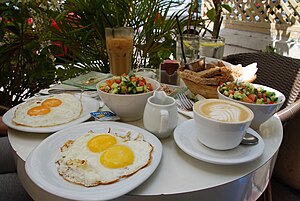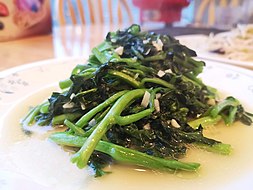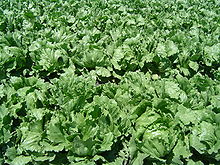
Back بوابة:مطاعم وطعام Arabic প্রবেশদ্বার:খাদ্য Bengali/Bangla دەروازە:خۆراک CKB Portál:Gastronomie Czech Portal:Essen und Trinken German Portalo:Nutrado kaj gastronomio Esperanto Portal:Alimentos Spanish Portaal:Toit Estonian درگاه:خوراک Persian Portail:Alimentation et gastronomie French
F o o d
A portal dedicated to food and foodways
Introduction


Food is any substance consumed by an organism for nutritional support. Food is usually of plant, animal, or fungal origin and contains essential nutrients such as carbohydrates, fats, proteins, vitamins, or minerals. The substance is ingested by an organism and assimilated by the organism's cells to provide energy, maintain life, or stimulate growth. Different species of animals have different feeding behaviours that satisfy the needs of their metabolisms and have evolved to fill a specific ecological niche within specific geographical contexts.
Omnivorous humans are highly adaptable and have adapted to obtain food in many different ecosystems. Humans generally use cooking to prepare food for consumption. The majority of the food energy required is supplied by the industrial food industry, which produces food through intensive agriculture and distributes it through complex food processing and food distribution systems. This system of conventional agriculture relies heavily on fossil fuels, which means that the food and agricultural systems are one of the major contributors to climate change, accounting for as much as 37% of total greenhouse gas emissions. (Full article...)
Cooking, also known as cookery or professionally as the culinary arts, is the art, science and craft of using heat to make food more palatable, digestible, nutritious, or safe. Cooking techniques and ingredients vary widely, from grilling food over an open fire, to using electric stoves, to baking in various types of ovens, reflecting local conditions. Cooking is an aspect of all human societies and a cultural universal.
Preparing food with heat or fire is an activity unique to humans. Archeological evidence of cooking fires from at least 300,000 years ago exists, but some estimate that humans started cooking up to 2 million years ago.
The expansion of agriculture, commerce, trade, and transportation between civilizations in different regions offered cooks many new ingredients. New inventions and technologies, such as the invention of pottery for holding and boiling of water, expanded cooking techniques. Some modern cooks apply advanced scientific techniques to food preparation to further enhance the flavor of the dish served. (Full article...)

Israeli cuisine primarily comprises dishes brought from the Jewish diaspora, and has more recently been defined by the development of a notable fusion cuisine characterized by the mixing of Jewish cuisine and Arab cuisine. It also blends together the culinary traditions of the various diaspora groups, namely those of Middle Eastern Jews with roots in Southwest Asia and North Africa, Sephardi Jews from Iberia, and Ashkenazi Jews from Central and Eastern Europe.
The country's cuisine also incorporates food and drinks traditionally included in other Middle Eastern cuisines (e.g., Iranian cuisine from Persian Jews and Turkish cuisine from Turkish Jews) as well as in Mediterranean cuisines, such that spices like za'atar and foods such as falafel, hummus, msabbaha, shakshouka, and couscous are now widely popular in Israel. However, the identification of Arab dishes as Israeli has led to accusations of cultural appropriation against Israel by Palestinians and other Arabs. (Full article...)
Selected article –

Stir frying (Chinese: 炒; pinyin: chǎo; Wade–Giles: ch'ao3; Cantonese Yale: cháau) is a cooking technique in which ingredients are fried in a small amount of very hot oil while being stirred or tossed in a wok. The technique originated in China and in recent centuries has spread into other parts of Asia and the West. It is similar to sautéing in Western cooking technique.
Wok frying may have been used as early as the Han dynasty (206 BC – 220 AD) for drying grain, not for cooking. It was not until the Ming dynasty (1368–1644) that the wok reached its modern shape and allowed quick cooking in hot oil. However, there is research indicating that metal woks and stir-frying of dishes were already popular in the Song dynasty (960–1279), and stir-frying as a cooking technique is mentioned in the 6th-century AD Qimin Yaoshu. Stir frying has been recommended as a healthy and appealing method of preparing vegetables, meats, and fish, provided calories are kept at a reasonable level. (Full article...)Selected cuisine -
Polish cuisine (Polish: kuchnia polska) is a style of food preparation originating in and widely popular in Poland. Due to Poland's history, Polish cuisine has evolved over the centuries to be very eclectic, and shares many similarities with other national cuisines. Polish cooking in other cultures is often referred to as à la polonaise.
Polish cuisine is rich in meat, especially pork, chicken and game, in addition to a wide range of vegetables, spices, fungi and mushrooms, and herbs. It is also characterised by its use of various kinds of pasta, cereals, kasha and pulses. In general, Polish cuisine makes extensive use of butter, cream, eggs, and seasoning. Traditional dishes often demand lengthy preparation. Many Poles take time to serve and enjoy their festive meals, especially Christmas Eve dinner (Wigilia) on December 24, or Easter breakfast, both of which could take several days to prepare. (Full article...)Selected ingredient –
Worcestershire sauce or Worcester sauce (UK: /ˈwʊstər(ʃər)/ WUUST-ər(-shər)) is a fermented liquid condiment invented by the pharmacists John Wheeley Lea and William Henry Perrins in the city of Worcester in Worcestershire, England, during the first half of the 19th century. The inventors went on to form the company Lea & Perrins.
Worcestershire sauce has been a generic term since 1876, when the English High Court of Justice ruled that Lea & Perrins did not own a trademark for the name "Worcestershire". (Full article...)
Selected recipe –
The ratio of ingredients and mixing method determines the texture of the crust. If the flour is not well mixed with the shortening, then water can bind to the available flour causing the gluten protein matrix to become over developed. This would result in a tough crust, as opposed to a flaky crust, which is more desirable. (Full article...)
Lettuce (Lactuca sativa) is an annual plant of the family Asteraceae. It is most often grown as a leaf vegetable, but sometimes for its stem and seeds. Lettuce is most often used for salads, although it is also seen in other kinds of food, such as soups, sandwiches and wraps; it can also be grilled. One variety, celtuce (asparagus lettuce), is grown for its stems, which are eaten either raw or cooked. In addition to its main use as a leafy green, it has also gathered religious and medicinal significance over centuries of human consumption. Europe and North America originally dominated the market for lettuce, but by the late 20th century the consumption of lettuce had spread throughout the world. , world production of lettuce and chicory was 27 million tonnes, 53 percent of which came from China.
Lettuce was originally farmed by the ancient Egyptians, who transformed it from a plant whose seeds were used to obtain oil into an important food crop raised for its succulent leaves and oil-rich seeds. Lettuce spread to the Greeks and Romans; the latter gave it the name lactuca, from which the English lettuce is derived. By 50 AD, many types were described, and lettuce appeared often in medieval writings, including several herbals. The 16th through 18th centuries saw the development of many varieties in Europe, and by the mid-18th century, cultivars were described that can still be found in modern gardens. (Full article...)Selected image –

Selected biography –
B. April 1, 1755, Belley, France – d. February 2, 1826, Paris
"Tell me what you eat, and I will tell you what you are."
Brillat-Savarin
Jean Anthelme Brillat-Savarin (French pronunciation: [ʒɑ̃ ɑ̃tɛlm bʁija savaʁɛ̃], (2 April 1755 – 2 February 1826) was a French lawyer and politician, who, as the author of Physiologie du goût (The Physiology of Taste), became celebrated for his culinary reminiscences and reflections on the craft and science of cookery and the art of eating.
Rising to modest eminence in the last years of France's Ancien Régime, Brillat-Savarin had to escape into exile when the Reign of Terror began in 1793. He spent nearly three years in the United States, teaching French and playing the violin to support himself, before returning to France when it became safe to do so, resuming his career as a lawyer, and rising to the top of the French judiciary. (Full article...)
Did you know (auto-generated) –

- ... that in 1776 Abraham Hunt entertained Hessian mercenaries with food and drink to render them incapable for duty the night before George Washington defeated them at Trenton?
- ... that staff at the vegan food brand VFC interact with internet trolls on social media platforms to grow their online brand?
- ... that British architect Diane Haigh transformed one historic building into an art gallery and another into a hospice?
- ... that Mary Earle was born near Ben Nevis, and although she became a professor of food technology in New Zealand, she never forgot her Scottish roots?
- ... that the reactions to food depicted in the manga series Food Wars!: Shokugeki no Soma were decided on through free association games?
- ... that because of the increasing prevalence of sesame allergy, the U.S. will join the EU and Canada in 2023 in instituting mandatory food labeling?
More did you know –
Related portals
Food topics
The following are topics relating to food
Categories
Food list articles
- See also: Lists of foods and Category:Lists of drinks
The following are some Food list articles on Wikipedia:

- American cheeses
- Appellation d'Origine Contrôlée cheeses
- Apple cultivars
- Bacon dishes
- Bacon substitutes
- Basil cultivars
- Breads
- Breakfast beverages
- Breakfast cereals
- Breakfast foods
- British cheeses
- Cakes
- Candies
- Cheeses
- Cheese soups
- Christmas dishes (list)
- Cocktails
- Cookies
- Dishes using coconut milk
- Diets
- Doughnut varieties
- Egg dishes
- Fermented soy products
- Food additives
- Food additives (Codex Alimentarius)
- Foods named after people
- French cheeses
- French dishes
- Fried dough foods
- Fruits
- List of hamburgers
- Herbs and spices
- Hors d'oeuvre
- Indian dishes
- Indian snack foods
- Indonesian dishes
- Italian dishes
- Japanese snacks
- Japanese dishes
- Jewish dishes
- Kebabs
- Korean beverages
- Mango cultivars
- Moroccan dishes
- Pasta
- Pastries
- Philippine snack food
- Pies, tarts and flans
- Poppy seed pastries and dishes
- Potato dishes
- Puddings
- Raw fish dishes
- Rice dishes
- Rolled foods
- Sauces
- Seafood
- Seeds
- Sandwiches
- Snack foods
- Soft drinks by country
- Soul foods and dishes
- Soups
- Stews
- Street foods
- Tapas
- Turkish dishes
- Twice-baked foods
- Vegetable oils
- Vegetables
- Vodkas
Things you can do
Related WikiProjects
| Parent project: WikiProject Food and Drink | |
| Child projects: | Task forces: (All inactive) |
|
|
| Related projects: | |
New articles
Rules | Match log | Results page (for watching) | Last updated: 2024-08-06 19:16 (UTC)
Note: The list display can now be customized by each user. See List display personalization for details.
- Food Ethics (journal) (edit | talk | history | links | watch | logs | tools) by J Milburn (talk · contribs · new pages (5)) started on 2024-08-06, score: 10
- Lawrence Mumar (edit | talk | history | links | watch | logs | tools) by YssaLang (talk · contribs · new pages (74)) started on 2024-08-06, score: 10
- Gazoza (Prilep) (edit | talk | history | links | watch | logs | tools) by Direktorot (talk · contribs · new pages (1)) started on 2024-08-05, score: 10
- Leo Hirschfield (edit | talk | history | links | watch | logs | tools) by Nightscream (talk · contribs · new pages (1)) started on 2024-08-05, score: 20
- Hakrim Dabang (edit | talk | history | links | watch | logs | tools) by Seefooddiet (talk · contribs · new pages (22)) started on 2024-08-02, score: 10
- Bruce M. Nicol (edit | talk | history | links | watch | logs | tools) by WheelHelms WS (talk · contribs · new pages (4)) started on 2024-08-05, score: 10
- Mangifera caloneura (edit | talk | history | links | watch | logs | tools) by Tropwine (talk · contribs · new pages (6)) started on 2024-08-05, score: 10
- Brijesh K. Tiwari (edit | talk | history | links | watch | logs | tools) by Bernie Clay Bear (talk · contribs · new pages (1)) started on 2024-08-05, score: 10
- Bujurquina syspilus (edit | talk | history | links | watch | logs | tools) by Phil Fish (talk · contribs · new pages (26)) started on 2024-08-05, score: 10
- Furai (edit | talk | history | links | watch | logs | tools) by Arsene10 (talk · contribs · new pages (4)) started on 2024-08-05, score: 10
- Frutillada (edit | talk | history | links | watch | logs | tools) by JustEMV (talk · contribs · new pages (17)) started on 2024-08-04, score: 10
- Choco Togo (edit | talk | history | links | watch | logs | tools) by Yue (talk · contribs · new pages (19)) started on 2024-08-04, score: 10
- Pariolius armillatus (edit | talk | history | links | watch | logs | tools) by Big Blue Cray(fish) Twins (talk · contribs · new pages (31)) started on 2024-08-04, score: 10
- Tamari Bar (edit | talk | history | links | watch | logs | tools) by Another Believer (talk · contribs · new pages (42)) started on 2024-07-31, score: 10
- Lexington Barbecue (edit | talk | history | links | watch | logs | tools) by Another Believer (talk · contribs · new pages (42)) started on 2024-08-04, score: 10
- Jeon Ha-young (edit | talk | history | links | watch | logs | tools) by Adamtt9 (talk · contribs · new pages (86)) started on 2024-08-03, score: 10
- Ambpoeial (edit | talk | history | links | watch | logs | tools) by Hangshangs (talk · contribs · new pages (2)) started on 2024-08-03, score: 30
- Adriano Go (edit | talk | history | links | watch | logs | tools) by YssaLang (talk · contribs · new pages (74)) started on 2024-08-03, score: 10
- Lucy's (bar) (edit | talk | history | links | watch | logs | tools) by 9t5 (talk · contribs · new pages (13)) started on 2024-08-02, score: 10
- Premna microphylla (edit | talk | history | links | watch | logs | tools) by Awkwafaba (talk · contribs · new pages (120)) started on 2024-08-02, score: 10
- Hutaoli (edit | talk | history | links | watch | logs | tools) by AirQuinn (talk · contribs · new pages (2)) started on 2024-08-02, score: 10
- Poinpy (edit | talk | history | links | watch | logs | tools) by Gisrhgver (talk · contribs · new pages (2)) started on 2024-08-01, score: 20
- Coat of arms of Sudbury (edit | talk | history | links | watch | logs | tools) by WikiPhil012 (talk · contribs · new pages (7)) started on 2024-08-01, score: 10
- Daiwa House Premist Dome (edit | talk | history | links | watch | logs | tools) by SoftReverie (talk · contribs · new pages (0)) started on 2024-08-01, score: 10
- Chin Mee Chin Confectionery (edit | talk | history | links | watch | logs | tools) by Imbluey2 (talk · contribs · new pages (11)) started on 2024-08-01, score: 10
- Prince Edward County wine (edit | talk | history | links | watch | logs | tools) by Abatishchev (talk · contribs · new pages (1)) started on 2024-08-01, score: 10
- Heinrich Bennecke (edit | talk | history | links | watch | logs | tools) by Historybuff0105 (talk · contribs · new pages (9)) started on 2024-07-31, score: 10
- Schwartauer Werke (edit | talk | history | links | watch | logs | tools) by Theanonymoustypist (talk · contribs · new pages (6)) started on 2024-07-23, score: 20
- Sudhir Sastry (edit | talk | history | links | watch | logs | tools) by HRShami (talk · contribs · new pages (12)) started on 2024-07-31, score: 10
- Izze (drink) (edit | talk | history | links | watch | logs | tools) by Atubofsilverware (talk · contribs · new pages (5)) started on 2024-07-31, score: 30
- Carmona Wine Urn (edit | talk | history | links | watch | logs | tools) by NeverBeGameOver (talk · contribs · new pages (4)) started on 2024-07-31, score: 10
- Moisés Gómez (baseball) (edit | talk | history | links | watch | logs | tools) by Stonecold415 (talk · contribs · new pages (10)) started on 2024-07-31, score: 10
- Thiere (edit | talk | history | links | watch | logs | tools) by Monomi0 (talk · contribs · new pages (2)) started on 2024-07-30, score: 10
- Quest Nutrition (edit | talk | history | links | watch | logs | tools) by BanjoZebra (talk · contribs · new pages (6)) started on 2024-07-19, score: 20
- Food shaming (edit | talk | history | links | watch | logs | tools) by GobsPint (talk · contribs · new pages (12)) started on 2024-07-30, score: 10
- Tottiford, Kennick, and Trenchford Reservoirs (edit | talk | history | links | watch | logs | tools) by Owain.davies (talk · contribs · new pages (9)) started on 2024-07-29, score: 10
- Bryan Sammons (edit | talk | history | links | watch | logs | tools) by Muboshgu (talk · contribs · new pages (12)) started on 2024-07-29, score: 10
- Hy (company) (edit | talk | history | links | watch | logs | tools) by FrederickEvans (talk · contribs · new pages (82)) started on 2024-07-29, score: 20
- Masterfoods (edit | talk | history | links | watch | logs | tools) by Pidzz (talk · contribs · new pages (15)) started on 2024-07-29, score: 40
- Hydrox Corporation (edit | talk | history | links | watch | logs | tools) by Bluethricecreamman (talk · contribs · new pages (4)) started on 2024-07-29, score: 30
- Marmelada de Santa Luzia (edit | talk | history | links | watch | logs | tools) by BaduFerreira (talk · contribs · new pages (3)) started on 2024-07-28, score: 30
- Mangifera applanata (edit | talk | history | links | watch | logs | tools) by Tropwine (talk · contribs · new pages (6)) started on 2024-07-28, score: 10
- Avec (restaurant) (edit | talk | history | links | watch | logs | tools) by Another Believer (talk · contribs · new pages (42)) started on 2024-07-26, score: 10
- Oh Seung-hoon (curler) (edit | talk | history | links | watch | logs | tools) by TracyFleuryFan (talk · contribs · new pages (13)) started on 2024-07-27, score: 10
- Neary's (edit | talk | history | links | watch | logs | tools) by Voorts (talk · contribs · new pages (24)) started on 2024-07-27, score: 10
- Phin (restaurant) (edit | talk | history | links | watch | logs | tools) by Another Believer (talk · contribs · new pages (42)) started on 2024-07-27, score: 10
- Parliamentary Under-Secretary of State for Nature (edit | talk | history | links | watch | logs | tools) by THeShavidow1 (talk · contribs · new pages (13)) started on 2024-07-27, score: 10
- T. B. Robson (edit | talk | history | links | watch | logs | tools) by Doug butler (talk · contribs · new pages (13)) started on 2024-07-27, score: 10
- Nepal Foods (edit | talk | history | links | watch | logs | tools) by HibaShaikh (talk · contribs · new pages (1)) started on 2024-07-27, score: 10
- Analog Coffee (edit | talk | history | links | watch | logs | tools) by Another Believer (talk · contribs · new pages (42)) started on 2024-07-27, score: 10
- The Green Tree Distillery (edit | talk | history | links | watch | logs | tools) by MonikaKubasakova (talk · contribs · new pages (1)) started on 2024-07-27, score: 10
- Café Hagen (edit | talk | history | links | watch | logs | tools) by Another Believer (talk · contribs · new pages (42)) started on 2024-07-23, score: 10
- Mannion v. Coors Brewing Co. (edit | talk | history | links | watch | logs | tools) by Daniel Case (talk · contribs · new pages (6)) started on 2024-07-25, score: 10
- Meldon Reservoir (edit | talk | history | links | watch | logs | tools) by Owain.davies (talk · contribs · new pages (9)) started on 2024-07-24, score: 10
- Pendennis Club (cocktail) (edit | talk | history | links | watch | logs | tools) by Nbarth (talk · contribs · new pages (5)) started on 2024-07-24, score: 10
- Lewis Orford (footballer) (edit | talk | history | links | watch | logs | tools) by 86.18.110.36 (talk · contribs · new pages (1)) started on 2024-07-24, score: 10
- Hags (restaurant) (edit | talk | history | links | watch | logs | tools) by MainlyTwelve (talk · contribs · new pages (16)) started on 2024-07-23, score: 10
- Angelito Esguerra (edit | talk | history | links | watch | logs | tools) by YssaLang (talk · contribs · new pages (74)) started on 2024-07-23, score: 10
- Moon Si-woo (edit | talk | history | links | watch | logs | tools) by TracyFleuryFan (talk · contribs · new pages (13)) started on 2024-07-23, score: 10
Associated Wikimedia
The following Wikimedia Foundation sister projects provide more on this subject:
-
Commons
Free media repository -
Wikibooks
Free textbooks and manuals -
Wikidata
Free knowledge base -
Wikinews
Free-content news -
Wikiquote
Collection of quotations -
Wikisource
Free-content library -
Wikiversity
Free learning tools -
Wiktionary
Dictionary and thesaurus
Sources
More portals
© MMXXIII Rich X Search. We shall prevail. All rights reserved. Rich X Search















































